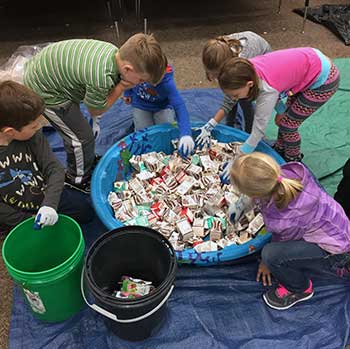Students find out how to decrease waste by dumping it, sorting it, and analyzing it.
 Clark County residents produce nearly 10.4 million tons of waste each month. Schools definitely contribute to that amount of waste. Waste is anything we no longer want. Sometimes waste is recyclable, occasionally it is reusable, often it is garbage ending up in a landfill, and at times it is even avoidable. Reducing that amount of waste would be best for our environment, for our earth, and certainly for us. Action is needed and when students know there’s a problem, they want to take action.
Clark County residents produce nearly 10.4 million tons of waste each month. Schools definitely contribute to that amount of waste. Waste is anything we no longer want. Sometimes waste is recyclable, occasionally it is reusable, often it is garbage ending up in a landfill, and at times it is even avoidable. Reducing that amount of waste would be best for our environment, for our earth, and certainly for us. Action is needed and when students know there’s a problem, they want to take action.
Have you ever wondered how often recyclables end up in the garbage cans? How often garbage is tossed in the recycle bin? Are you and your students curious about how much waste (garbage, recyclables and food waste) your school produces in a day? The best way to find out is to dive in — sort it and analyze it. A waste audit is instructive, involving lots of weighing and measuring; it’s a real eye opener, it’s a little messy and it’s also fun. An understanding of items disposed of (as detailed as you choose) can shed light on problems as well as identifying potential opportunities; it is very useful for inspiring change.
The Clark County Green Schools program has access to all the waste audit materials needed, and would be happy to help you plan and run your waste audit. A waste audit can be done with any group of students: a Green Team, a science class, student leaders or any representative group of students and their advisors. It can be done during the school day or after school.
Waste Audit basics
Weigh & measure
Garbage and recycling for one full day is collected and labeled by area. The weight and volume of the total garbage and recycling is recorded and then sorted by students wearing gloves and using tongs. Various waste items are sorted into buckets representing different waste streams. Students weigh and measure bucket contents and these amounts are subtracted from the total weight, thus producing a measure of ‘true garbage’ and ‘true recycling’ produced in a day. Sorted waste streams are also weighed, measured, and recorded.
Evaluate
Students and teachers later study the waste audit results and draw conclusions. Additionally if there is a high concentration of a certain type of waste, steps can be taken to reduce it. For example, if there is a high amount of plastic cutlery then a letter could be written by the students to the kitchen staff and food service provider including the data showing how much plastic cutlery makes up the total garbage. Included would be an explanation of why changing to metal silverware would be economically and environmentally beneficial.
Take action
A waste audit is a fantastic way to kick off environmental change and raise awareness at your school. Then later in the year it’s important to hold a second waste audit to determine how the changes in behavior affected the amount and composition of your school’s waste.
What's a waste audit like? Check out this video from a 2018 waste audit at Hockinson Heights Elementary School, produced by the students and staff!


